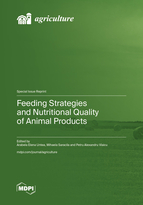Feeding Strategies and Nutritional Quality of Animal Products
A special issue of Agriculture (ISSN 2077-0472). This special issue belongs to the section "Farm Animal Production".
Deadline for manuscript submissions: closed (15 April 2023) | Viewed by 16928
Special Issue Editors
Interests: oxidative stability of foods; food design; natural antioxidants and mechanisms of action; lipid peroxidation; food shelf life; in vivo and in vitro methods for antioxidant activity and bioavailability assessment; extraction methods; isolation of plant active compounds; waste valorization
Special Issues, Collections and Topics in MDPI journals
Interests: monogastric animals; phytoadditives; by-products; gut microbiota; heat stress; hydrophilic antioxidants; oxidative stress, meat quality
Special Issues, Collections and Topics in MDPI journals
Interests: food quality; bioactive compounds; fatty acids; antioxidants; functional foods; feed; food; animals; nutrition
Special Issues, Collections and Topics in MDPI journals
Special Issue Information
Dear Colleagues,
The production of food enriched with bioactive compounds, through natural ways, represents a concept desired by nutritionists, doctors and consumers. Animal products with high nutritional quality can be designed using innovative feeding strategies. Animals are known to be able to ‘‘bio-convert’’ health-promoting components from their diet into their eggs, milk or meat, and these products enriched with various nutrients align with the increasing concern for human health and health-conscious consumers. The nutritional quality of animal products depends on genetic, physiological and environmental conditions but also on diets. Lately, various feed additives have been shown to increase the nutritional quality of animal-origin food, which in turn promotes a healthy human diet. Some of them have proven effects on productive parameters or on sensory attributes of animal products or modify the nutrient composition of products. The quality of animal products is closely related to the quality of animal feeds. Nutritional evaluations of animal products and feeds are necessary for establishing the bioconversion yield of nutrients from feeds to animal-origin food.
This Special Issue focuses on, but is not limited to, the development of new feeding formulas which lead to improved animal production or enhanced nutritional profiles of conventional or ecological animal products. Feed additives that have beneficial effects on the production and quality of animal products as well as natural feeding solutions that are environmentally friendly are also welcome. The proposed Special Issue is addressed to specialists from the domains of animal nutrition, food quality, chemistry and biology.
Dr. Arabela Elena Untea
Dr. Mihaela Saracila
Dr. Petru Alexandru Vlaicu
Guest Editors
Manuscript Submission Information
Manuscripts should be submitted online at www.mdpi.com by registering and logging in to this website. Once you are registered, click here to go to the submission form. Manuscripts can be submitted until the deadline. All submissions that pass pre-check are peer-reviewed. Accepted papers will be published continuously in the journal (as soon as accepted) and will be listed together on the special issue website. Research articles, review articles as well as short communications are invited. For planned papers, a title and short abstract (about 100 words) can be sent to the Editorial Office for announcement on this website.
Submitted manuscripts should not have been published previously, nor be under consideration for publication elsewhere (except conference proceedings papers). All manuscripts are thoroughly refereed through a single-blind peer-review process. A guide for authors and other relevant information for submission of manuscripts is available on the Instructions for Authors page. Agriculture is an international peer-reviewed open access monthly journal published by MDPI.
Please visit the Instructions for Authors page before submitting a manuscript. The Article Processing Charge (APC) for publication in this open access journal is 2600 CHF (Swiss Francs). Submitted papers should be well formatted and use good English. Authors may use MDPI's English editing service prior to publication or during author revisions.
Keywords
- feeds
- bioactive compounds
- product quality
- meat, eggs, milk
- nutritional evaluation methods
- animal production
- functional food
- ecological animal products








